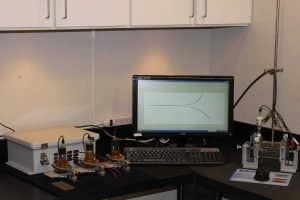IGS specialize in the onsite application of thermal spray systems, be they specialized High Velocity Thermal Spray (HVTS) supersonic application of high nobility alloys internally on critical process equipment or the application of low nobility alloys using standard low velocity equipment in challenging circumstances. IGS are the largest onsite applicator of specialist thermal spray solutions in the world, with a global team of trained and certified project managers and technicians. We provide engineered solutions to challenging metal wastage problems, such as the application of a sacrificial Aluminium coating to the external surfaces of low temperature or cycling process equipment and pipework (sweating pipework), online, keeping the plant operating.
Thermal Spray Aluminium is a proven technology for Corrosion Under Insulation protection, specified for many years by the major oil companies such as Shell, ExxonMobil and Saudi Aramco, with a typical life expectancy of more than 25 years. The original application quality is critical and will have a direct correlation with the performance of the as applied corrosion barrier. The unmatched site experience of IGS in executing projects to strict quality standards in tight time schedules on shutdown / turnaround critical paths of downstream petrochemical assets, puts us in a unique position to provide the asset integrity manager with a turnkey, long-term solution to corrosion under insulation, applied outside of the shutdown on live plant, avoiding the requirement for extended shutdowns and reducing future plant turnaround scope and schedule. We spray metal alloy coatings in North America, Europe, Middle East, Africa, Asia, and other parts of the world.
Corrosion Under Insulation continues to cost the downstream petrochemical industry billions of dollars and is the stuff of nightmares for many production or asset integrity managers. It can be a hidden menace, proceeding undetected until a loss of containment occurs, leading to an emergency plant shutdown required or even worse, a major incident. CUI is a risk at every process plant, across a huge range of process equipment.
Corrosion Under Insulation has been studied over many years at thousands of facilities and the operating equipment deemed to be most at risk is the plant operating at low temperatures (not cryogenic, but below the typical atmospheric temperature) or in cyclic operation (thermally cycling from cold too hot to cold etc.). Both these conditions lead to sweating service, where condensation forms on the equipment or pipework external surface, providing the liquid required to initiate corrosion activity if no protective barrier is in place. The rate of corrosion is then dependent upon many factors including the temperature, the presence of conductive salts (e.g. Chlorides) from the environment (e.g. coastal locations or offshore platforms) or leaching from insulation, the dwell time or duration of temperature cycles etc. etc.

Preventing CUI can be achieved by many different corrosion management strategies. To prevent corrosion taking place the equipment designer or operator needs to ensure that the elements required for corrosion, commonly referred to as the Anode, Cathode, Metallic Pathway and Environment, are not allowed to develop. For Corrosion Under Insulation this can be done by controlling the environment (e.g. removing moisture), upgrading the substrate alloy etc. However, by far the most common method is utilizing a corrosion barrier or coating, to isolate the metal substrate from the environment and in addition to organic or non-metallic systems, the most common and widespread technology adopted is the application of Thermal Sprayed Aluminium.
Despite the higher initial costs, TSA selected by operators due to the comparative life cycle cost or cost of ownership of the applied system and the achievable return on investment. When the application is properly controlled a Thermal Sprayed Aluminium coating will protect the substrate for more than 25 years, whereas an organic or non-metallic conventional coating system will typically require replacement or maintenance every 5 years. It means five (5) applications of the conventional coating system compared to one (1) application of Thermal Sprayed Aluminium over a 25-year cycle, leading to savings in maintenance, labour and materials. In addition, Thermal Sprayed Aluminium is a robust metallic material, resistant to impact damage and further still will galvanically protect the substrate if locally damaged.
TSA is a tried and trusted corrosion barrier technology designed to stop corrosion under insulation and to protect the external surfaces of process pipework and equipment for extended periods (more than 25 years). Thermal Sprayed Aluminium has been used in the downstream petrochemical industry for more than 50 years.
TSA works by effectively isolating the substrate material (typically carbon steel) from the corrosion environment (electrolyte or conductive liquid), acting as a protective corrosion barrier, to break the corrosion cycle. In addition, Thermal Sprayed Aluminium provides secondary protection of the carbon steel as a sacrificial anode.
The Aluminium will galvanically corrode in preference to the Carbon Steel substrate due to its lower nobility. So, if localized mechanical damage occurs to the TSA coating, there is still galvanic protection against pitting corrosion of the carbon steel.

The application standard of TSA is critical to the success of the applied coating as a long-term solution against Corrosion Under Insulation. The process must be carefully monitored and controlled, to manage the application standard and quality. A robust quality control process and inspection protocol is crucial.
Thermal Sprayed Aluminium coating requires thorough surface preparation, to a white metal (SA3 or NACE 1) cleanliness standard and an average surface roughness of typically 75 to 125 microns (3 to 5 mils), this is achieved through grit blasting which is typically carried out with an open blasting system.
The application of TSA is carried out with a standard thermal spray process, either using twin wire arc spray or flame spray systems, according to NORSOK M-501 and ISO 2063.
Both of these processes create a significant amount of dust and debris, typically the application is carried out during a shutdown, when the plant is offline.
Many downstream petrochemical processing plants have CUI mitigation programs with the application of TSA to protect large areas of the plant, by carrying out these applications during a shutdown the plant is limiting the opportunities to carry out other work and dramatically increasing the scope and schedule of the shutdown/turnaround.
For this reason, IGS has developed containment and application methods to safely apply TSA online.
With our expertise in delivering onsite solutions to downstream petrochemical plants IGS are uniquely positioned to provide engineered thermal spray solutions. We are the first to apply TSA coatings on live plant, on sweating pipes, with condensation on the surface.
Application of Thermal Sprayed Aluminium online requires experienced and knowledgeable operators and project managers.
By providing clients with online TSA application, IGS enables the plant to move these projects out of their shutdown scope, allowing other key value adding maintenance and process enhancement projects to take place and more plant uptime / productivity.